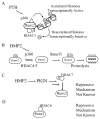Regulation of gene expression in osteoblasts
- PMID: 20087883
- PMCID: PMC2820584
- DOI: 10.1002/biof.72
Regulation of gene expression in osteoblasts
Abstract
In recent years, much progress has been made in understanding the factors that regulate the gene expression program that underlies the induction, proliferation, differentiation, and maturation of osteoblasts. A large and growing number of transcription factors make important contributions to the precise control of osteoblast formation and function. It has become increasingly clear that these diverse transcription factors and the signals that regulate their activity cannot be viewed as discrete, separate signaling pathways. Rather, they form a highly interconnected, cooperative network that permits gene expression to be closely regulated. There has also been a substantial increase in our understanding of the mechanistic control of gene expression by cofactors such as acetyltransferases and histone deacetylases. The purpose of this review is to highlight recent progress in understanding the major transcription factors and epigenetic coregulators, including histone deacetylases and microRNAs, involved in osteoblastogenesis and the mechanisms that determine their functions as regulators of gene expression.
Figures

References
-
- Tapscott SJ. The circuitry of a master switch: Myod and the regulation of skeletal muscle gene transcription. Development. 2005;132:2685–2695. - PubMed
-
- Tontonoz P, Spiegelman BM. Fat and beyond: the diverse biology of PPARgamma. Annu Rev Biochem. 2008;77:289–312. - PubMed
-
- de Crombrugghe B, Lefebvre V, Behringer RR, Bi W, Murakami S, Huang W. Transcriptional mechanisms of chondrocyte differentiation. Matrix Biol. 2000;19:389–394. - PubMed
-
- Komori T, Yagi H, Nomura S, Yamaguchi A, Sasaki K, Deguchi K, Shimizu Y, Bronson RT, Gao YH, Inada M, Sato M, Okamoto R, Kitamura Y, Yoshiki S, Kishimoto T. Targeted disruption of Cbfa1 results in a complete lack of bone formation owing to maturational arrest of osteoblasts. Cell. 1997;89:755–764. - PubMed
-
- Otto F, Thornell AP, Crompton T, Denzel A, Gilmour KC, Rosewell IR, Stamp GW, Beddington RS, Mundlos S, Olsen BR, Selby PB, Owen MJ. Cbfa1, a candidate gene for cleidocranial dysplasia syndrome, is essential for osteoblast differentiation and bone development. Cell. 1997;89:765–771. - PubMed
Publication types
MeSH terms
Substances
Grants and funding
LinkOut - more resources
Full Text Sources

